BEAR JOURNAL 2009
Hau Kea
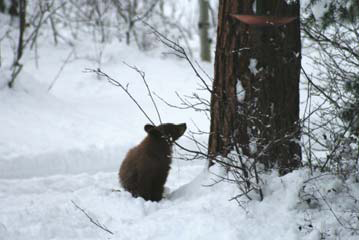 Our New Year’s bear arrived January 4th, 2009 at 11.5 pounds. Her story is a sad and difficult one in
which she struggled to survive on her own for a long time. She clearly shows us that whether we
succeed or fail to save them in the end, we have to try. Apparently she had been spotted back in
September, but they didn’t realize she was an orphan. How she managed to last as long as she did is
amazing. It speaks to a bear’s determination to survive. Most of us humans would probably have given
up long before she did. We don’t know how she was orphaned, but she is the smallest cub Washington
has ever sent us at 11 months old.
Our New Year’s bear arrived January 4th, 2009 at 11.5 pounds. Her story is a sad and difficult one in
which she struggled to survive on her own for a long time. She clearly shows us that whether we
succeed or fail to save them in the end, we have to try. Apparently she had been spotted back in
September, but they didn’t realize she was an orphan. How she managed to last as long as she did is
amazing. It speaks to a bear’s determination to survive. Most of us humans would probably have given
up long before she did. We don’t know how she was orphaned, but she is the smallest cub Washington
has ever sent us at 11 months old.
The Hawaiian name Hau Kea means snow. She was named that
by the Olson family who spotted her and reported the orphaned
cub to Fish and Wildlife. Their 11 year old son picked that name
when Sally told them IBBR names the cubs Native American or
Hawaiian names. She is a bear that had to deal with plenty of
snow as the pictures show. She was spotted in the remote
mountains on the Entiat River between Lake Chelan and
Wenatchee. They said she seemed very weak and lethargic
which was to be expected being so underweight. It had snowed
about four feet prior to when they spotted her.
Temperatures
ranged from 13 below to 20 above.
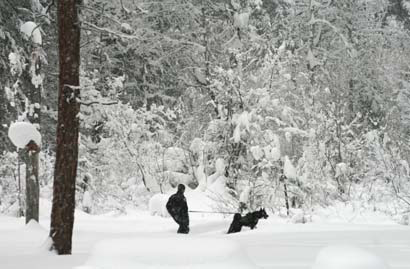 Rich Beausoleil had already sent us several cubs in 2008 and set out to find this cub the next day. He
brought along his bear dog to help track the cub. The dog
found the cub within an hour hiding under a fallen tree
with branches that protected her and gave her a place to
get out of the snow. She was pretty weak, unable to climb
very far up a tree. She only put up the obligatory fight, but
was too weak to do much.
Rich Beausoleil had already sent us several cubs in 2008 and set out to find this cub the next day. He
brought along his bear dog to help track the cub. The dog
found the cub within an hour hiding under a fallen tree
with branches that protected her and gave her a place to
get out of the snow. She was pretty weak, unable to climb
very far up a tree. She only put up the obligatory fight, but
was too weak to do much.
After the vet check, who rated her a 1 on a scale of 1 to
10, they got her ready for transport. Once again Terri,
Larry, & their dog Pearl headed out to pick her up. We put
her in the deck enclosure when she arrived and she looked
so small in there even though it’s not very big. The first
night she ate just the formula, cottage cheese and yogurt.
The next day she ate twice as much, but left the solid fruit and dog food. That was her choice over the
next 2 days. We gave her antibiotics, Nutra Cal, and Pet Tabs to supplement. Then she began eating the
apples and grapes and there was no stopping her after that. Sally had a camera on her enclosure and
observed her 21 hours a day. As she gained weight she became pretty sassy. Everyone thought she was
going to make it.
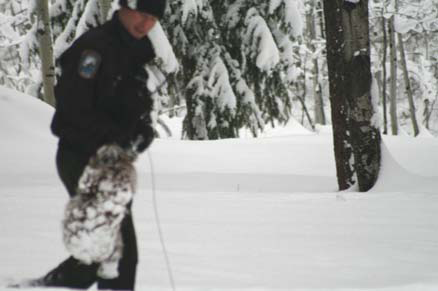 Poor little Hau Kea had shown no signs of any problems, her eyes and nose were clear, her stools looked good,
she was on antibiotics, and eating better than expected. She gained some weight and we were all thrilled she was
doing so well with such a shaky start. Then her world and ours caved in on us. On Saturday January 10th, she
went in her den about 9:30pm and pulled the hay in after her. Sally worked until about 3am and watched,
but expected she was in for the night.
Poor little Hau Kea had shown no signs of any problems, her eyes and nose were clear, her stools looked good,
she was on antibiotics, and eating better than expected. She gained some weight and we were all thrilled she was
doing so well with such a shaky start. Then her world and ours caved in on us. On Saturday January 10th, she
went in her den about 9:30pm and pulled the hay in after her. Sally worked until about 3am and watched,
but expected she was in for the night.
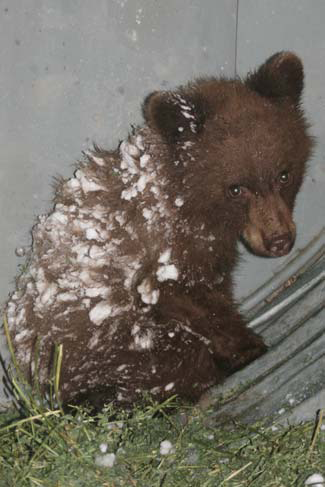 The next morning, one week to the day since she arrived, she
came out of the den and appeared to be wobbling. Sally went out immediately and it was obvious something was
terribly wrong. She sat with her head down, no sass in her at all, breathing a little hard. Dr. Murphy
arrived and the little cub didn’t even put up a fight to our handling her. Dr. Murphy said her lungs were
congested and gave her some penicillin and stronger antibiotics. We all kept hoping she could fight it off,
but her tiny body had taken as much as it could. She passed away quietly that day. It was heart breaking for
everyone. One of the hardest parts of wildlife rehabilitation is when you see the animal improve, appear to
be winning the fight, and then take a turn for the worse. At this point we don’t know if the antibiotic did
it’s job for a while then just wasn’t enough or if it was failing her all along. Bears are expert at hiding
symptoms, but in her case there just weren’t any symptoms until the day of her death. Although it is probably
pneumonia, we’ll see what the vet says when he is finished examining her.
The next morning, one week to the day since she arrived, she
came out of the den and appeared to be wobbling. Sally went out immediately and it was obvious something was
terribly wrong. She sat with her head down, no sass in her at all, breathing a little hard. Dr. Murphy
arrived and the little cub didn’t even put up a fight to our handling her. Dr. Murphy said her lungs were
congested and gave her some penicillin and stronger antibiotics. We all kept hoping she could fight it off,
but her tiny body had taken as much as it could. She passed away quietly that day. It was heart breaking for
everyone. One of the hardest parts of wildlife rehabilitation is when you see the animal improve, appear to
be winning the fight, and then take a turn for the worse. At this point we don’t know if the antibiotic did
it’s job for a while then just wasn’t enough or if it was failing her all along. Bears are expert at hiding
symptoms, but in her case there just weren’t any symptoms until the day of her death. Although it is probably
pneumonia, we’ll see what the vet says when he is finished examining her.
For Hau Kea and all the other orphaned cubs that aren’t found or
brought in, all of us at IBBR will keep fighting to save these cubs and
hope the next time there will be a different outcome. We will never
know much of what she went through to survive and the difficulties
she faced or how she managed it. We can only imagine with what
little we do know. She inspires all of us to be there, to never stop
trying to help other cubs who will follow her. Hau Kea will be buried
on the property this spring.
Pu’iwa
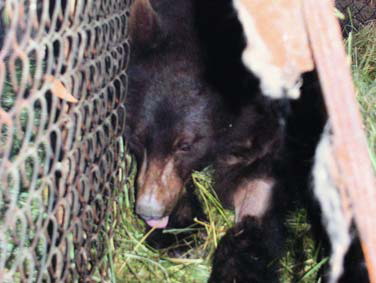
Usually we name the bear based on personality or behavior
once we get a chance to know them. This time we named the
bear Hawaiian for “Surprise”! He was a surprise to us when he
arrived. Bears are called cubs during the first year of their life.
They are born in January or February and when they reach the
end of their first year & begin the second year of life they are
called yearlings. All the bears we have now were born in 2008
and are just now turning to yearlings. When Washington
called January 22 & said a yearling, we just assumed it was a
2008 cub. Terri & Larry arrived the next day with bear and his
behavior and physical size seemed to indicate a yearling in
2008 and was now staring his 3rd year. He was very
emaciated, weighing only 26lbs. Notice the size of those paws!
Either way, he was a surprise so we named him accordingly.
Pu’iwa was scheduled to go in the deck enclosure so we could monitor him closely as we do all starved
bears. However, one look at him on arrival and we knew that wasn’t going to happen. We could manage
to get him in even though the entrance is intended for smaller cubs, but it would be impossible to keep
him there more than a couple of days. Getting him out without tranquilizing him would have been an
amazing feat even if we could accomplish it. Considering his condition, the less tranquilizing the better.
Aside from that, with his size we would practically be nose to nose when feeding and cleaning unless he
was in the den area. Sally wasn’t quite ready to provide herself as protein to his diet. We decided to put
him into the enclosure recently occupied by Ano’i Pua and
Ka’ahina as they were now with Wasaka in the adjoining
enclosure.
All the enclosures have cameras and can be
monitored.
Some we can record video, but with this enclosure we
could only monitor him. He immediately hid out behind the
slanted board & filled the whole width of it.
As soon as we left he
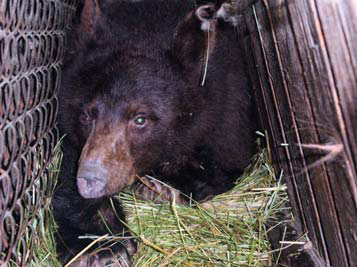 came out and began pulling at tugging at wire and wood panels
in front of the wire. Bears will test the enclosures immediately
and if they don’t find any weakness, they generally stop looking.
Older bears are more persistent than cubs of the year. Sally
monitored him throughout the night to be sure he wasn’t
continuing to work on the enclosure. He tested the side panels
and then settled down and just scanned the whole enclosure.
came out and began pulling at tugging at wire and wood panels
in front of the wire. Bears will test the enclosures immediately
and if they don’t find any weakness, they generally stop looking.
Older bears are more persistent than cubs of the year. Sally
monitored him throughout the night to be sure he wasn’t
continuing to work on the enclosure. He tested the side panels
and then settled down and just scanned the whole enclosure.
After about an hour, he moved up to the food, drank the formula first, then the cottage cheese
& yogurt as they always do. The bears just seem to sense the formula is needed to help turn around the
starvation. He spent time in the back den, sleeping on the hay in front of the den and wandering around
the enclosure just staring at things. He was immediately aware of the three bears in the adjoining
enclosure and they were very much aware of him. In fact for the first full day Pu’iwa was here, those
three spent 95% of their time in the dens. Ano’i Pua was a bit funny as she tried so hard to eat the food
while keeping one hind foot in the den as if that would protect her. Of course it was impossible and
eventually they all came out long enough to eat and then ran back in the den. It will take a few days for
both sides to adjust.
Pu’iwa seemed a bit restless the second day and had eaten everything except
the apples, grapes, and dog food. Not surprising as that’s usually the
routine for the first few days. However, Sally felt we needed to increase
what he was eating until he began taking the solid fruit and dog food. We
doubled all three amounts, added the antibiotics to the yogurt, and put the
Pet Tabs & Nutra Cal in the cottage cheese. As you read
this, he has been eating all that and the solid fruit and dog food.
Still, after the sad death of Hua Kea, none of us will breath easy
for 10-14 days. As soon as he has built up his weight, Pu’iwa
will probably go in the den and hibernate for whatever time is
left before spring weather arrives. He has already began pulling hay in the den to build it up so it’s just a
waiting game now.
WASHINGTON CUBS - KAULANA AND KUHILANI
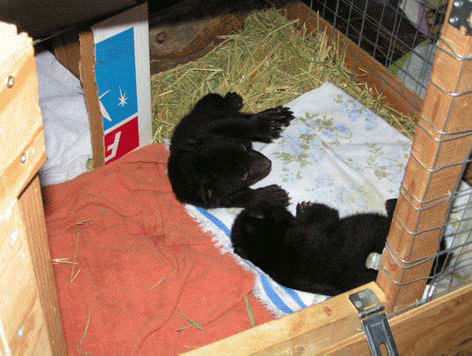 Another special opportunity came to IBBR with
an e-mail on February 25, 2009 from a retired veterinarian in Washington
about two tiny cubs left on his doorstep. Sally immediately called and spoke
to him about the cubs. After their conversation he contacted Washington
Dept. of Fish and Wildlife. Rich Beausoleil picked up the tiny cubs
estimated to be 4 weeks old with eyes just opening.
Another special opportunity came to IBBR with
an e-mail on February 25, 2009 from a retired veterinarian in Washington
about two tiny cubs left on his doorstep. Sally immediately called and spoke
to him about the cubs. After their conversation he contacted Washington
Dept. of Fish and Wildlife. Rich Beausoleil picked up the tiny cubs
estimated to be 4 weeks old with eyes just opening.
Cubs that age would still be in the den with their mother. Did someone disturb
the den, chase the mother off and take the cubs? Did mom abandon the cubs
and they crawled their way out to be found by someone in the area? Did
someone kill the mother and steal the cubs? We will never know what happened
except it is not normal for cubs this age to be out of the den. Whoever left
the cubs on the veterinarian’s doorstep at least knew they would be taken
care of.
Thursday, February 26th our transport team left to meet Washington
Dept. of Fish and Wildlife. Sally sent them off with formula and bottles, a
quick instruction on how to bottle feed baby cubs with all the tips to go
with it. They did just fine and arrived back in Garden City with their tiny
charges late that same day. Sally had the indoor enclosure ready to go.
After another bottle feeding, the cubs fell sound asleep. Then began the
schedule of feeding and stimulating bowel movements every two hours around
the clock.
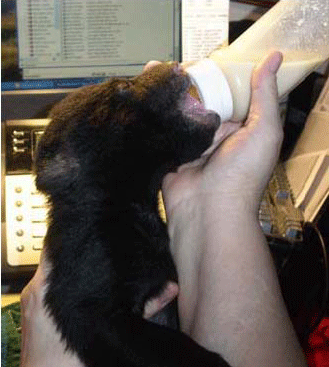
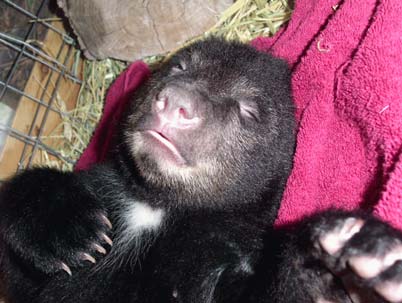 The cubs weighed 3 ½ lbs and 4 lbs - both males and both black. As their
personalities began to show, Sally named them Kaulana (Hawaiian for quiet)
and Kuhilani (Hawaiian for commanding or bossy). Kaulana had a small white
patch on his chest and Kuhilani had a bigger patch of white. But they were
easy tell apart by their personalities. Kaulana was the one that was laid
back and Kuhilani was charging into everything and taking the lead. As they
grow, that changes and the reverse roles a few times.
The cubs weighed 3 ½ lbs and 4 lbs - both males and both black. As their
personalities began to show, Sally named them Kaulana (Hawaiian for quiet)
and Kuhilani (Hawaiian for commanding or bossy). Kaulana had a small white
patch on his chest and Kuhilani had a bigger patch of white. But they were
easy tell apart by their personalities. Kaulana was the one that was laid
back and Kuhilani was charging into everything and taking the lead. As they
grow, that changes and the reverse roles a few times.
For a while there was a loud bawling as one or the other got stretched out on
his back & couldn’t turn over. No matter what time it was, Sally would have
to come to the rescue and roll them back over on their stomach.
First signs of play started about March 5 with mouthing followed by the awkward attempts
to grab an ear or paw on the other cub. They were also taking some
tentative, if not clumsy steps. Three days later they were showing signs of
being able to focus better as sudden movements would sometimes startle them.
By March 10 Sally could feel the teeth like little mountains getting ready
to erupt through the skin. Although there were signs the ears were open,
they weren’t reacting to sounds until around March 17th.
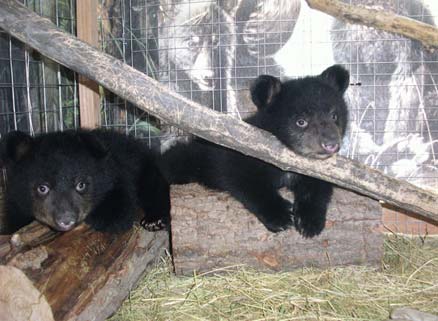 It’s always fun to watch those first tentative steps, the fall to the side, the
get up and do it again until finally their balance kept them on all fours.
Then those initial attempts at play - a paw slowly reaching out as if in a
swat, only to loose balance and fall over again. By March 20th
they were able to climb the wire, wrestling and playing, and even a woof or
two if startled. They began taking tiny bits of peaches and soft foods a few
days later. It would be about ten days later before they really ate much of
the solid food.
It’s always fun to watch those first tentative steps, the fall to the side, the
get up and do it again until finally their balance kept them on all fours.
Then those initial attempts at play - a paw slowly reaching out as if in a
swat, only to loose balance and fall over again. By March 20th
they were able to climb the wire, wrestling and playing, and even a woof or
two if startled. They began taking tiny bits of peaches and soft foods a few
days later. It would be about ten days later before they really ate much of
the solid food.
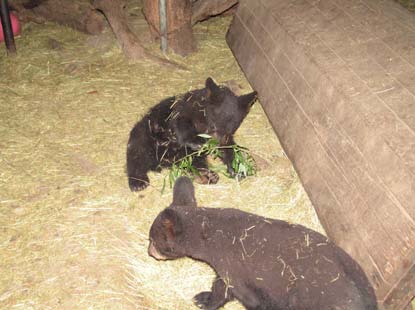
The next stage was to move them to the deck enclosure during the day. They were
ready for that on April 17th. Sally brought them in each night
until they adjusted and stayed in the deck enclosure full time.
By May 8th
they were quickly outgrowing the deck enclosure so we moved them to the next
enclosure. They chased and played and jumped into the water tub and then
soaked the clean dry hay we just put down. It wasn’t long before that larger
enclosure next to them was so appealing they constantly stared through the
chain link wanting to get over there. So on May 23rd, we opened
the door between the two and off they went. Normally we leave the door open
for a few days and let them go back & forth.
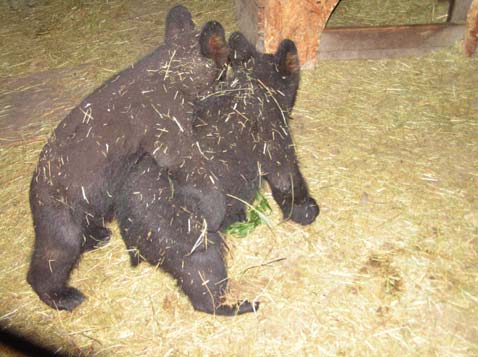 Since they wanted over there so
badly we thought they would be content and we latched the door shut. Sure
enough, 10pm and they were bawling at the top of their lungs. Sally went out
and unlatched the door so they could spend the night in the same den. They
went back and forth for several days until the triplets from Utah were
coming and the door was latched again.
Since they wanted over there so
badly we thought they would be content and we latched the door shut. Sure
enough, 10pm and they were bawling at the top of their lungs. Sally went out
and unlatched the door so they could spend the night in the same den. They
went back and forth for several days until the triplets from Utah were
coming and the door was latched again.
They won’t be weaned until the end of June at the earliest. These two haven’t
taken as quickly to the solid food diet so they might need more time with
formula. Like most cubs their age, they sleep, chase each other endlessly,
wrestle, chase, sleep and it starts all over again. They somehow managed to
get to the camera in the rear of the enclosure & ripped out the wires.
Wonder what devious plot they are up to now that they didn’t want Sally to
see via the camera?
In about 3 weeks when the Utah triplets are settled in and Mahalo (see below)
has merged with them, we will put all 6 cubs together and the real comedy
will begin.
WASHINGTON TWINS KUHILANI & KAULANA RELEASED
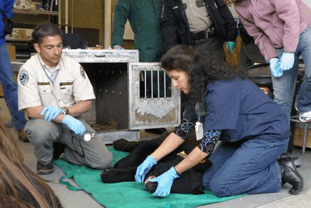
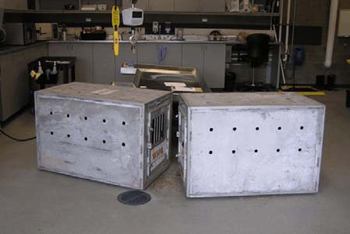 On May 19th, Kuhilani & Kaulana, the Washington twins left to return to Washington. Although they came
from the Wenatchee area, Washington Fish & Wildlife asked if we could meet them in Spokane. They
planned a training session for their wildlife officers in handling bears and wanted to show them how to
ear tag, radio collar, tattoo, and do a general health check. Our transport team, Larry & Terri Limberg
left Boise on 5/19 with one bear in each carrier. They called on the way to say the bears were not happy
and were doing some major aerobics the whole way. Thank heavens it wasn’t winter with slick roads or
the IBBR truck would have been all over the road. Upon arrival in Spokane Valley, the bears were held
overnight in a locked facility at the Fish & Wildlife office. They were fed and watered and the carriers
turned so they were facing each other. Both settled
down for the night - probably exhausted from all their
shenanigans during the trip.
On May 19th, Kuhilani & Kaulana, the Washington twins left to return to Washington. Although they came
from the Wenatchee area, Washington Fish & Wildlife asked if we could meet them in Spokane. They
planned a training session for their wildlife officers in handling bears and wanted to show them how to
ear tag, radio collar, tattoo, and do a general health check. Our transport team, Larry & Terri Limberg
left Boise on 5/19 with one bear in each carrier. They called on the way to say the bears were not happy
and were doing some major aerobics the whole way. Thank heavens it wasn’t winter with slick roads or
the IBBR truck would have been all over the road. Upon arrival in Spokane Valley, the bears were held
overnight in a locked facility at the Fish & Wildlife office. They were fed and watered and the carriers
turned so they were facing each other. Both settled
down for the night - probably exhausted from all their
shenanigans during the trip.
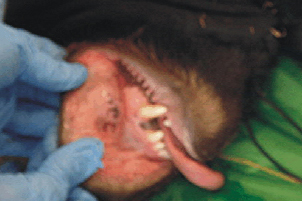 |
Tattoo on inner lip |
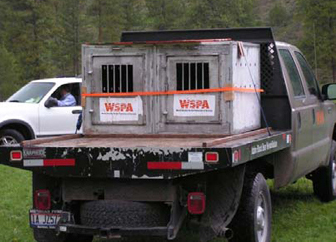 The next morning Rich Beausoleil held the training
session while preparing the twins for release. The
bears were tattooed, ear tagged, radio collared, and
weighed. IBBR’s scale was acting up the morning we
sent them back to Washington so we didn’t have
weights. Kaulana weighed in at 152 pounds and
Kuhilani was a whopping 201 pounds. These two were
only 4 weeks old when they arrived so they released
these two in a very remote area to limit chances of any
contact with people to give them some time to adjust
to their new world.
The next morning Rich Beausoleil held the training
session while preparing the twins for release. The
bears were tattooed, ear tagged, radio collared, and
weighed. IBBR’s scale was acting up the morning we
sent them back to Washington so we didn’t have
weights. Kaulana weighed in at 152 pounds and
Kuhilani was a whopping 201 pounds. These two were
only 4 weeks old when they arrived so they released
these two in a very remote area to limit chances of any
contact with people to give them some time to adjust
to their new world.
Following the Fish & Wildlife training session, IBBR’s transport team left for Wenatchee. Later that day
the twins were released in a beautiful area with a nice creek and plenty of food and trees to climb. F&W
checked on them a couple of days later & they were still
together, but did separate after that. As of 6/20/10
they have not been spotted or getting into any trouble.
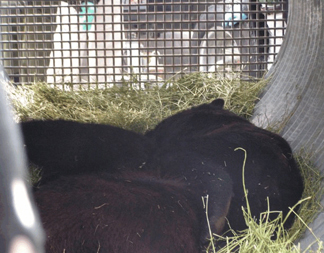
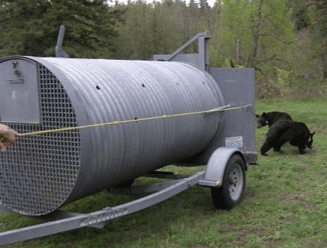
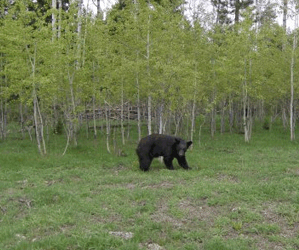
MAHALO
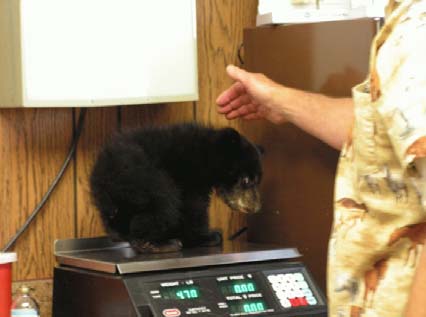 Next to arrive was a very tiny, very starved, very frightened cub from
Oregon. Her name is Hawaiian for thank you or giving thanks. She weighed
only 3 pounds and was the size of a Chihuahua with fur. She was
approximately 3 months old and should have been about 10-13 pounds. She
was developed enough that she didn’t look like a “baby”, but so tiny for
her age she looked like a mini bear. Everyone fell in love with her
immediately. Aside from her starvation, she had a touch of congestion in her lungs. We
don’t know what happened to her mother as she was found alone in a horse
corral with some very upset horses ready to stomp her. IBBR’s transport
team again headed out immediately on May 1 to bring her back to IBBR.
After a visit to the veterinarian, Oregon Fish and Wildlife met us half
way on the long drive so we could get her back here the same day.
Next to arrive was a very tiny, very starved, very frightened cub from
Oregon. Her name is Hawaiian for thank you or giving thanks. She weighed
only 3 pounds and was the size of a Chihuahua with fur. She was
approximately 3 months old and should have been about 10-13 pounds. She
was developed enough that she didn’t look like a “baby”, but so tiny for
her age she looked like a mini bear. Everyone fell in love with her
immediately. Aside from her starvation, she had a touch of congestion in her lungs. We
don’t know what happened to her mother as she was found alone in a horse
corral with some very upset horses ready to stomp her. IBBR’s transport
team again headed out immediately on May 1 to bring her back to IBBR.
After a visit to the veterinarian, Oregon Fish and Wildlife met us half
way on the long drive so we could get her back here the same day.
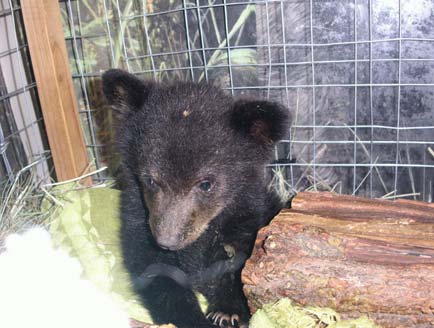
Today she is doing fine, but we are still fighting a bit of a rattle in
the lungs and she is still on antibiotics. She weighed in at 13 pounds
on June 3 and 18lbs on 6/11 so her weight and frame are now developing
nicely. She will never be a big bear after such a tiny start. She loves
to wrestle and attacks Sally to start a fight the minute she starts to
clean and feed. Although the claws are sharp and the teeth very much
present, she is gentle in her play.
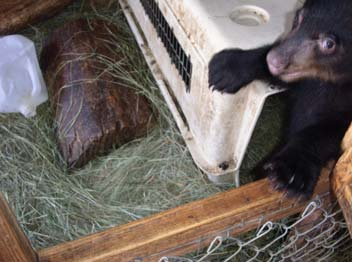 Wrestling is very important for bear cubs in learning to defend and protect
themselves in the future. For a short time yet Sally
will be the target for her wrestling. As soon as the lungs are clear,
she will join the Utah triplets below and they will be wrestling and
chasing together in no time. Shortly after that, the triplets and Mahalo
will join Kaulana & Kuhilani.
Wrestling is very important for bear cubs in learning to defend and protect
themselves in the future. For a short time yet Sally
will be the target for her wrestling. As soon as the lungs are clear,
she will join the Utah triplets below and they will be wrestling and
chasing together in no time. Shortly after that, the triplets and Mahalo
will join Kaulana & Kuhilani.
She goes in the outdoor deck enclosure during the day and comes back inside
for the night.
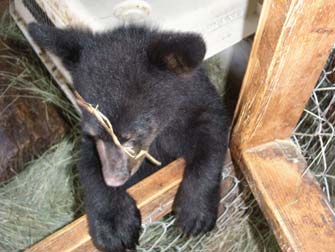 The weather has been difficult with big thunderstorms and
very heavy rain.
Not only is she frightened to be by herself during the
storms, but with a little rattle left in her lungs Sally didn’t want her
to stay outside at night. She keeps the room close to the outdoor
temperature so it doesn’t get too warm inside. Despite the noise of the
storms, with her foster mom nearby
Mahalo settles down for the night feeling quite safe and secure.
We anticipate putting her in the enclosure with the triplets in the next 10 days.
The weather has been difficult with big thunderstorms and
very heavy rain.
Not only is she frightened to be by herself during the
storms, but with a little rattle left in her lungs Sally didn’t want her
to stay outside at night. She keeps the room close to the outdoor
temperature so it doesn’t get too warm inside. Despite the noise of the
storms, with her foster mom nearby
Mahalo settles down for the night feeling quite safe and secure.
We anticipate putting her in the enclosure with the triplets in the next 10 days.
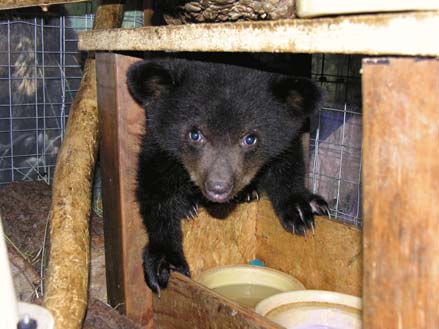 Everyone is excited to see her with them so she will have a buddy to wrestle with. We
just have one hurdle left and that’s the remaining bit of rattle in the
lungs.
Everyone is excited to see her with them so she will have a buddy to wrestle with. We
just have one hurdle left and that’s the remaining bit of rattle in the
lungs.
Considering her size, we may ask to hold her until next spring to give her
frame time to develop even more. Oregon Fish and Wildlife will decide
that later in the year. In the meantime, she will join the other cubs
and continue going through the stages of development with the others.
It’s a joy to see her growing each day. After losing two cubs from late
last year, we are all thrilled that this tiny cub managed to not only
survive, but is thriving so far.
SWEET MAHALO GOES HOME AT LAST
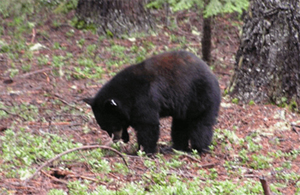 After Kuhilani & Kaulana left, poor Mahalo was lost. She went through the traumatic experience of losing
her best friend, Ikaika when he went back to Utah in December and now the Washington twins were
gone. We hoped to take Mahalo at the same time we took the twins. We even had two new carriers built to accommodate the three bears. However,
hunting season didn’t end in Oregon until 5/31 so she had to wait. After they left, she paced and
searched and pouted for several hours a day before finally giving up each day and taking a
much needed rest.
After Kuhilani & Kaulana left, poor Mahalo was lost. She went through the traumatic experience of losing
her best friend, Ikaika when he went back to Utah in December and now the Washington twins were
gone. We hoped to take Mahalo at the same time we took the twins. We even had two new carriers built to accommodate the three bears. However,
hunting season didn’t end in Oregon until 5/31 so she had to wait. After they left, she paced and
searched and pouted for several hours a day before finally giving up each day and taking a
much needed rest.
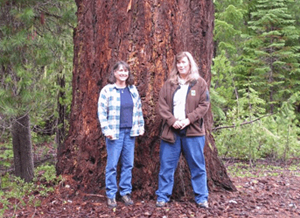 |
Look at the size of those trees!
That’s Terri (on the left)
& Oregon Fish
& Wildlife officer Rosemary Stussy. |
It was around 10 days after they left before she began eating normally, playing
in the swim tub, and amusing herself. It was very hard to see her so lonely during that time. At one
point she ripped a corner of the chain link in her determination to go find the other bears.
We had to immediately add a layer of chain link that was hog ringed from the top of the roof and
overlapped down the side about a foot and a half all the way around the enclosure. If she could do
it in one corner she could do it anywhere so it had to be done immediately. We spent two full days
getting that job done. While it was hard work for us, she seemed to be somewhat amused by us and
while we were working, she would stop pacing and sit on the logs and watch us. Sally said she would
miss sweet Mahalo as she was such a fun bear & so personable, especially with those big ears sticking
out the side of her head. After Mahalo’s little prank, two days of work & $1500 in materials Sally was
very ready for her to go home.
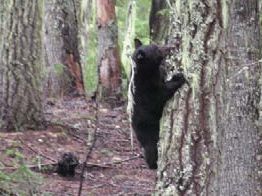 |
She looks so small on that huge tree |
When her big day came on 6/2, we were all so excited for her release. We wondered what went through her mind as bears aren’t stupid.
Twice before that day came and the other bears disappeared & now here we were again.
We tranquilized her and it went very smoothly. Our scale weighed her in at 116 pounds so she had good weight for a female.
Even though she was still a small bear, it was so much better to hold her for spring release to give her more time for her body frame to grow.
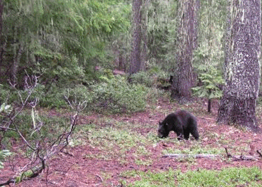 Oregon sent ear tags to us so we did the ear tagging here. Our transport team, Larry & Terri Limberg (and dog
Pearl) had a long drive to Oregon so they left immediately. Mahalo did the same aerobics as the
twins during the trip. The state wildlife office held her overnight since it was too late to release that day.
The officer who originally saved her, Rosemary Stussy took charge of her release as well. She located a
beautiful release site which afforded her a chance to adjust to her surroundings without running into
people. Mahalo was such a tiny, underweight cub when she arrived at IBBR and such a fun bear that we
knew we would miss her, but so excited for her new life to begin & hope she has a long life with cubs of
her own in the future.
Oregon sent ear tags to us so we did the ear tagging here. Our transport team, Larry & Terri Limberg (and dog
Pearl) had a long drive to Oregon so they left immediately. Mahalo did the same aerobics as the
twins during the trip. The state wildlife office held her overnight since it was too late to release that day.
The officer who originally saved her, Rosemary Stussy took charge of her release as well. She located a
beautiful release site which afforded her a chance to adjust to her surroundings without running into
people. Mahalo was such a tiny, underweight cub when she arrived at IBBR and such a fun bear that we
knew we would miss her, but so excited for her new life to begin & hope she has a long life with cubs of
her own in the future.
UTAH TRIPLETS
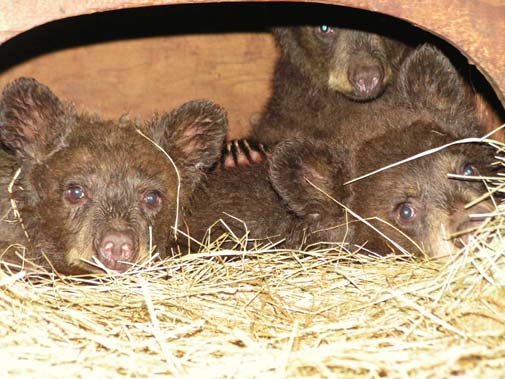 Monday June 1 the triplets arrived from Utah - one male and two females. Their mother was
shot during hunting season, but she had stashed the cubs out of sight and the hunter didn’t
realize she had cubs. As soon as he spotted them he contacted the Division of Wildlife Resources
to rescue the cubsThey were also very tiny, but considering she had 3 cubs that isn’t
surprising. They have settled in nicely next to the twins. As always, the first day or two is
taking stock of their new surroundings, deciding what is safe and what is questionable. They will
run out of hiding, grab a bite or two and then run back to hide. Eventually one gets brave and
stays out longer or climbs up on something and the others will follow suit.
Monday June 1 the triplets arrived from Utah - one male and two females. Their mother was
shot during hunting season, but she had stashed the cubs out of sight and the hunter didn’t
realize she had cubs. As soon as he spotted them he contacted the Division of Wildlife Resources
to rescue the cubsThey were also very tiny, but considering she had 3 cubs that isn’t
surprising. They have settled in nicely next to the twins. As always, the first day or two is
taking stock of their new surroundings, deciding what is safe and what is questionable. They will
run out of hiding, grab a bite or two and then run back to hide. Eventually one gets brave and
stays out longer or climbs up on something and the others will follow suit.
On June 2, we had to manhandle them to give them tetanus shots, check them over, and put on
tick medication. After even just one day of food and formula they went from being little wimps
to sassy little bears letting us know they didn’t like this manhandling business or the
shots. Sally got a nice deep scratch across her arm as memorabilia from that session, but
that’s just part of being a wildlife rehabilitator. She laughs and says she has more
scars on her arms than skin. Within a few more days they were romping, chasing, climbing
everything, and most importantly tipping over all the food dishes. However, like smart bears
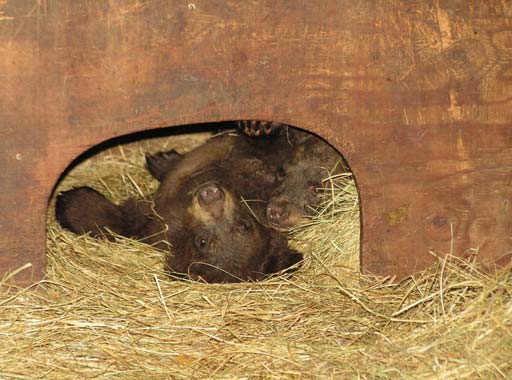 they quickly learned the formula was the # one item on the menu and did not dump those dishes.
With each day they drank more formula (no bottle feeding needed with these 3). That’s
exactly what we wanted to see so we installed the “formula dishes on legs”.
They are trays that hold the metal dishes and the bears can’t get the dishes out.
We wire it to the chain link and they can sit on the dens to drink the formula. Keeps it from
getting dirty, but nothing keeps little bear rear ends from sitting in it or bear paws from
swimming in it.
they quickly learned the formula was the # one item on the menu and did not dump those dishes.
With each day they drank more formula (no bottle feeding needed with these 3). That’s
exactly what we wanted to see so we installed the “formula dishes on legs”.
They are trays that hold the metal dishes and the bears can’t get the dishes out.
We wire it to the chain link and they can sit on the dens to drink the formula. Keeps it from
getting dirty, but nothing keeps little bear rear ends from sitting in it or bear paws from
swimming in it.
As of June 12, they were gaining weight, spending the majority of their day napping and playing.
They are completely comfortable in the enclosure now and watch curiously as we feed and clean.
Their favorite game is “turn over the fruit dish and spread it all over the hay”.
Eventually we will have more of the formula dishes on legs built that we can put the fruit in
to help prevent that mess. They are playing in the small water tub and their fur is starting
to look much better now.
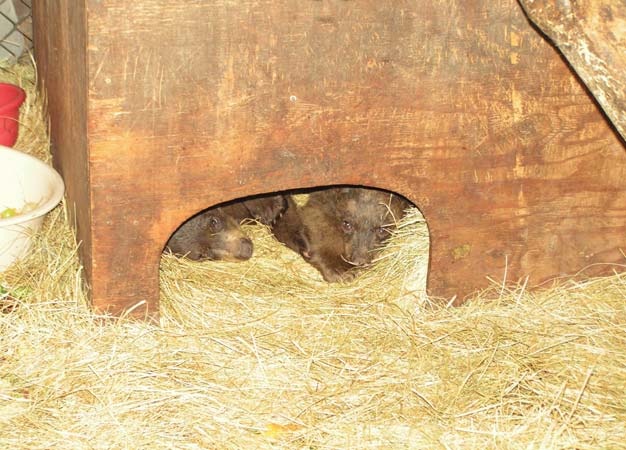
It’s nice to see them feeling safe and secure, especially knowing what a nightmare they
went through losing their mother and having their world turned upside down. The twins are aware
of them and they have been watching the twins chase around.
They can reach through the chain link if they want to socialize and probably will be doing that
before long. Nothing gets bear cubs to merge faster than a good game of chase and wrestle. By
the time we put Mahalo with the triplets it will only be a couple of weeks before all six will be
together. IBBR named one of the females Malihini (Hawaiian for Guest), the other female Pulama (Hawaiian
- to cherish), and the male Ikaika (Hawaiian for strong). Utah will be
coming to IBBR 11/30 to take the triplets back to Utah. Washington & Oregon
Bears will return home sometime after that in December.
DECEMBER 1, 2009 - RELEASE OF 2009 UTAH TRIPLETS
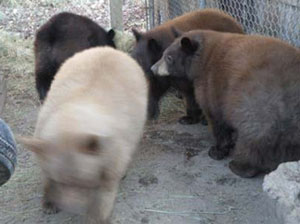 |
Ikaika (blonde), Mahalo behind him, and his two sisters |
We started preparing all the bears for hibernation in November. We taper the food supply, clean out the
dens, replace all the old grass hay, and hope the weather turns cold. The bears made it clear they were
going to den in the front part of the enclosure. Originally we had two dens there, but after seeing one
bear always lying outside the dens, we moved a third den up front. While bears will always den together
and like the confined areas, we thought it must be two crowded if one bear was always lying outside.
When that didn’t solve the problem, Sally watched on the monitor to see if it was one particular bear.
After watching for a couple of nights, the solution became clear. We had three separate dens and one
bear wanted to den with a specific bear and couldn’t fit in that one den. So we pulled the sides off two of
the dens, pushed all 3 together and formed one big den. Problem solved.
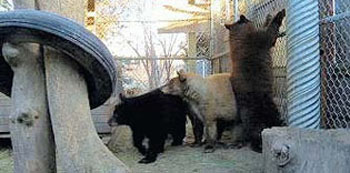 |
Ikaika & Mahalo & one of the 2 sisters |
Scheduled release date was December 1. Early on the morning of November 30, Utah Division of Wildlife
officers arrived to help prepare the cubs for transport back to Utah. The night before we rousted the two
Washington cubs, Kaulana and Kuhilani and moved them to the back part of the enclosure. They were
definitely not happy. They paced and tried to dig under the divider gate finally giving up about 1am and
going into a den in back.
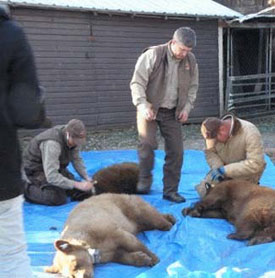 |
All 3 bears ready to load in transport trailer |
We left Mahalo up front because she was so attached to the Utah male, Ikaika. In her twenty years of
bear rehab, Sally said bears do make buddies, but only twice has she experienced the intense bonding
these two displayed. The other two bears were Jaws and his Nevada buddy. They actually pined for
each other while Jaws was separated after his surgery. Mahalo and Ikaika were constantly together and
Ikaika was very protective towards her. If one of the Washington males wanted to play or wrestle with
her, he would sometimes intercede and separate them. Maybe protecting her, maybe dominance practice
for when he was older and of breeding age, who knows. We felt it would stress both Mahalo and the
Utah triplets more if we moved Mahalo too and she would be easy enough to work around the next
morning. Little did we know the impact this separation would have for sweet Mahalo.
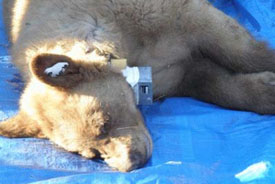 |
Ikaika with radio collar & ear tags |
The morning started about 730am with tranquilizing the three Utah cubs and moving them out of the
enclosure to get weights, measurements, radio collar and put in ear tags. Once all that work was
completed, the officers loaded them all three into the transport trailer. It was only a short time before all
three bears were alert and wondering what was going on now. Before Utah left with the bears, the two
females had pulled off the radio collars and Ikaika was trying very hard to pull his off. It was a long drive
home to the release site, but they would do fine and we were excited to see them finally back home and
free. While we don’t have any pictures of the release, Utah let us know that all went just fine. They put
the radio collars back on before release and after the release they sent us an update. One of the females
had dug her own den and the other female and Ikaika were close by and would probably den shortly.
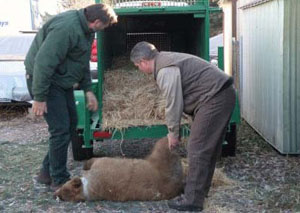 |
Ikaika ready to load in trailer |
After we took the three Utah cubs out of the enclosure, we let the two Washington cubs back up front
with Mahalo hoping their presence would offer some comfort and security to her. While she saw all the
action, grasping what was happening was another matter. Ikaika was there and then he was gone. The
loss of her buddy left her confused and searching for several weeks. She had such a difficult start to life
and everyone fell in love with her so it was heartbreaking to watch her search day after day for several
weeks for Ikaika. She would come out of the den several times during the night, stand and look all
around, just waiting. Sometimes we humans can put our own emotions and feelings onto animals, but
there was no mistaking what she was going through. Finally she would give up, go back in the den until
morning. During the days she would search the whole enclosure several times and then sit in front of the
den looking so forlorn and lost before finally going back inside. For people who say animals don’t have
feelings or emotions, we would challenge them to watch Mahalo in her search for Ikaika and continue to
believe they don’t have feelings. Separation at release time is just a fact of life for a bear, but that
doesn’t make it any easier on them or us.
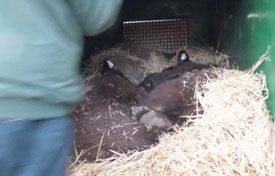 |
Can you spot all 3 bears in the trailer? |
We scheduled the other three bears to return to Washington and Oregon the middle of December, but
plans had to change. Oregon hunting season continued until December 31st and we don’t release bears
while hunting season is open. Washington also asked to delay their release due to the officers schedule.
We scheduled them again for January 23rd. This time weather thwarted our plans. It was so warm in
Washington that snow was melting and bears were coming out of their dens. With no food available and
bears becoming active 2-3 months early, it was a bad situation because our bears would not continue to
hibernate either. We decided to wait until the first part of February to see if the weather turned cold
again. Unfortunately, it turned even warmer here and the bears are active now and are no longer in
hibernation mode. So it looks like a spring release late in May after hunting season ends. Check back
after that for pictures and details on their release.
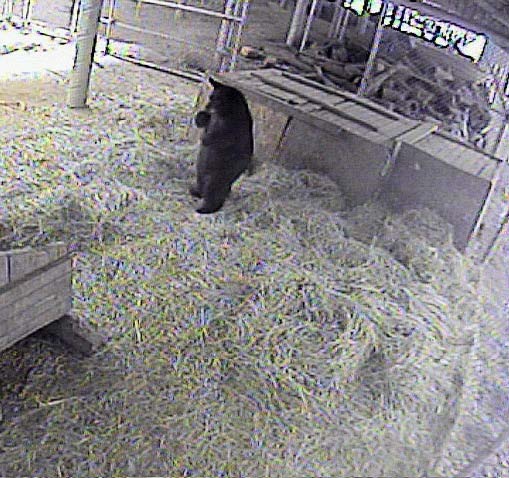 |
Mahalo out again looking for Ikaika 2 weeks after he left for Utah. After searching the
whole enclosure, she took one final look around & went back in the den. She was out
twice more that day and then three times during the night just sitting in front of the dens
as if waiting for Ikaika to show up.
|
|



 The next morning Rich Beausoleil held the training
session while preparing the twins for release. The
bears were tattooed, ear tagged, radio collared, and
weighed. IBBR’s scale was acting up the morning we
sent them back to Washington so we didn’t have
weights. Kaulana weighed in at 152 pounds and
Kuhilani was a whopping 201 pounds. These two were
only 4 weeks old when they arrived so they released
these two in a very remote area to limit chances of any
contact with people to give them some time to adjust
to their new world.
The next morning Rich Beausoleil held the training
session while preparing the twins for release. The
bears were tattooed, ear tagged, radio collared, and
weighed. IBBR’s scale was acting up the morning we
sent them back to Washington so we didn’t have
weights. Kaulana weighed in at 152 pounds and
Kuhilani was a whopping 201 pounds. These two were
only 4 weeks old when they arrived so they released
these two in a very remote area to limit chances of any
contact with people to give them some time to adjust
to their new world.



 Next to arrive was a very tiny, very starved, very frightened cub from
Oregon. Her name is Hawaiian for thank you or giving thanks. She weighed
only 3 pounds and was the size of a Chihuahua with fur. She was
approximately 3 months old and should have been about 10-13 pounds. She
was developed enough that she didn’t look like a “baby”, but so tiny for
her age she looked like a mini bear. Everyone fell in love with her
immediately. Aside from her starvation, she had a touch of congestion in her lungs. We
don’t know what happened to her mother as she was found alone in a horse
corral with some very upset horses ready to stomp her. IBBR’s transport
team again headed out immediately on May 1 to bring her back to IBBR.
After a visit to the veterinarian, Oregon Fish and Wildlife met us half
way on the long drive so we could get her back here the same day.
Next to arrive was a very tiny, very starved, very frightened cub from
Oregon. Her name is Hawaiian for thank you or giving thanks. She weighed
only 3 pounds and was the size of a Chihuahua with fur. She was
approximately 3 months old and should have been about 10-13 pounds. She
was developed enough that she didn’t look like a “baby”, but so tiny for
her age she looked like a mini bear. Everyone fell in love with her
immediately. Aside from her starvation, she had a touch of congestion in her lungs. We
don’t know what happened to her mother as she was found alone in a horse
corral with some very upset horses ready to stomp her. IBBR’s transport
team again headed out immediately on May 1 to bring her back to IBBR.
After a visit to the veterinarian, Oregon Fish and Wildlife met us half
way on the long drive so we could get her back here the same day.

 Wrestling is very important for bear cubs in learning to defend and protect
themselves in the future. For a short time yet Sally
will be the target for her wrestling. As soon as the lungs are clear,
she will join the Utah triplets below and they will be wrestling and
chasing together in no time. Shortly after that, the triplets and Mahalo
will join Kaulana & Kuhilani.
Wrestling is very important for bear cubs in learning to defend and protect
themselves in the future. For a short time yet Sally
will be the target for her wrestling. As soon as the lungs are clear,
she will join the Utah triplets below and they will be wrestling and
chasing together in no time. Shortly after that, the triplets and Mahalo
will join Kaulana & Kuhilani.
 The weather has been difficult with big thunderstorms and
very heavy rain.
Not only is she frightened to be by herself during the
storms, but with a little rattle left in her lungs Sally didn’t want her
to stay outside at night. She keeps the room close to the outdoor
temperature so it doesn’t get too warm inside. Despite the noise of the
storms, with her foster mom nearby
Mahalo settles down for the night feeling quite safe and secure.
We anticipate putting her in the enclosure with the triplets in the next 10 days.
The weather has been difficult with big thunderstorms and
very heavy rain.
Not only is she frightened to be by herself during the
storms, but with a little rattle left in her lungs Sally didn’t want her
to stay outside at night. She keeps the room close to the outdoor
temperature so it doesn’t get too warm inside. Despite the noise of the
storms, with her foster mom nearby
Mahalo settles down for the night feeling quite safe and secure.
We anticipate putting her in the enclosure with the triplets in the next 10 days.
 Everyone is excited to see her with them so she will have a buddy to wrestle with. We
just have one hurdle left and that’s the remaining bit of rattle in the
lungs.
Everyone is excited to see her with them so she will have a buddy to wrestle with. We
just have one hurdle left and that’s the remaining bit of rattle in the
lungs.
 After Kuhilani & Kaulana left, poor Mahalo was lost. She went through the traumatic experience of losing
her best friend, Ikaika when he went back to Utah in December and now the Washington twins were
gone. We hoped to take Mahalo at the same time we took the twins. We even had two new carriers built to accommodate the three bears. However,
hunting season didn’t end in Oregon until 5/31 so she had to wait. After they left, she paced and
searched and pouted for several hours a day before finally giving up each day and taking a
much needed rest.
After Kuhilani & Kaulana left, poor Mahalo was lost. She went through the traumatic experience of losing
her best friend, Ikaika when he went back to Utah in December and now the Washington twins were
gone. We hoped to take Mahalo at the same time we took the twins. We even had two new carriers built to accommodate the three bears. However,
hunting season didn’t end in Oregon until 5/31 so she had to wait. After they left, she paced and
searched and pouted for several hours a day before finally giving up each day and taking a
much needed rest.


 Oregon sent ear tags to us so we did the ear tagging here. Our transport team, Larry & Terri Limberg (and dog
Pearl) had a long drive to Oregon so they left immediately. Mahalo did the same aerobics as the
twins during the trip. The state wildlife office held her overnight since it was too late to release that day.
The officer who originally saved her, Rosemary Stussy took charge of her release as well. She located a
beautiful release site which afforded her a chance to adjust to her surroundings without running into
people. Mahalo was such a tiny, underweight cub when she arrived at IBBR and such a fun bear that we
knew we would miss her, but so excited for her new life to begin & hope she has a long life with cubs of
her own in the future.
Oregon sent ear tags to us so we did the ear tagging here. Our transport team, Larry & Terri Limberg (and dog
Pearl) had a long drive to Oregon so they left immediately. Mahalo did the same aerobics as the
twins during the trip. The state wildlife office held her overnight since it was too late to release that day.
The officer who originally saved her, Rosemary Stussy took charge of her release as well. She located a
beautiful release site which afforded her a chance to adjust to her surroundings without running into
people. Mahalo was such a tiny, underweight cub when she arrived at IBBR and such a fun bear that we
knew we would miss her, but so excited for her new life to begin & hope she has a long life with cubs of
her own in the future.
 Monday June 1 the triplets arrived from Utah - one male and two females. Their mother was
shot during hunting season, but she had stashed the cubs out of sight and the hunter didn’t
realize she had cubs. As soon as he spotted them he contacted the Division of Wildlife Resources
to rescue the cubsThey were also very tiny, but considering she had 3 cubs that isn’t
surprising. They have settled in nicely next to the twins. As always, the first day or two is
taking stock of their new surroundings, deciding what is safe and what is questionable. They will
run out of hiding, grab a bite or two and then run back to hide. Eventually one gets brave and
stays out longer or climbs up on something and the others will follow suit.
Monday June 1 the triplets arrived from Utah - one male and two females. Their mother was
shot during hunting season, but she had stashed the cubs out of sight and the hunter didn’t
realize she had cubs. As soon as he spotted them he contacted the Division of Wildlife Resources
to rescue the cubsThey were also very tiny, but considering she had 3 cubs that isn’t
surprising. They have settled in nicely next to the twins. As always, the first day or two is
taking stock of their new surroundings, deciding what is safe and what is questionable. They will
run out of hiding, grab a bite or two and then run back to hide. Eventually one gets brave and
stays out longer or climbs up on something and the others will follow suit.
 they quickly learned the formula was the # one item on the menu and did not dump those dishes.
With each day they drank more formula (no bottle feeding needed with these 3). That’s
exactly what we wanted to see so we installed the “formula dishes on legs”.
They are trays that hold the metal dishes and the bears can’t get the dishes out.
We wire it to the chain link and they can sit on the dens to drink the formula. Keeps it from
getting dirty, but nothing keeps little bear rear ends from sitting in it or bear paws from
swimming in it.
they quickly learned the formula was the # one item on the menu and did not dump those dishes.
With each day they drank more formula (no bottle feeding needed with these 3). That’s
exactly what we wanted to see so we installed the “formula dishes on legs”.
They are trays that hold the metal dishes and the bears can’t get the dishes out.
We wire it to the chain link and they can sit on the dens to drink the formula. Keeps it from
getting dirty, but nothing keeps little bear rear ends from sitting in it or bear paws from
swimming in it.







